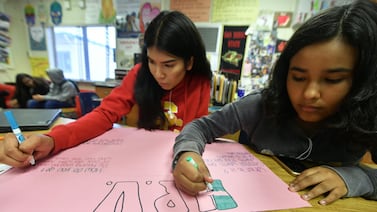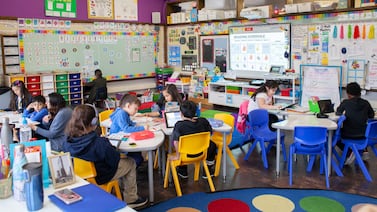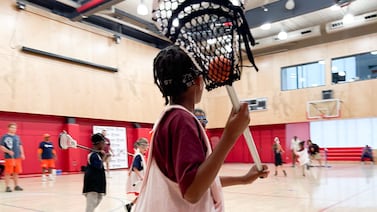Sign up for Chalkbeat New York’s free daily newsletter to get essential news about NYC’s public schools delivered to your inbox.
The switch to OMNY cards for the New York City public school system has been a boon to students across the boroughs.
And as the Education Department and Metropolitan Transportation Authority gear up for the coming school year, some major changes could be afoot — including the material they’re made of, the ability to use them on cellphones, and who is eligible, Education Department officials said Thursday at a Chancellor’s Parent Advisory Committee meeting.
More than half a million students received OMNY cards through this year’s new initiative, providing up to four free rides all day, 365 days a year. (Previously, Metrocards only offered three daily rides during limited hours on school days.) New York City paid the MTA roughly $50.5 million for 1.5 million cards, and has so far delivered about 60% of those cards to schools, Education Department officials recently told Chalkbeat.
But complaints from parents and schools have been growing louder about damaged, lost, and deactivated cards as the school year enters the spring term. Some schools have reported long waits to get replacement cards, prompting concerns especially for migrant students who could face severe consequences, including possible deportation, for jumping a turnstile to get to school. Education Department officials, however, have said schools should get replacement cards about a week after requesting them.
Here’s what could change next year:
The flimsy paper material used for the student OMNY cards could soon be a thing of the past.
The Education Department is in discussions with the Metropolitan Transportation Authority and the vendor who makes the cards to explore changes to the cards’ material and durability, La-Nikka Parker-Moore, from the Education Department’s Office of Pupil Transportation, told members of the Chancellor’s Parent Advisory Committee on Thursday.
“Mom puts it in the wash by mistake, it’s in the pocket, or kids’ juice is spilling,” Parker-Moore said. “They’re getting damaged more.”
MTA officials confirmed they are looking into more durable materials for student OMNY passes.
Another way Parker-Moore hoped to address the issue was to move to having virtual student OMNY cards, she said.
Anticipating some wear-and-tear and lost cards, the Education Department this year provided extra cards to schools so they have replacement cards on hand, Parker-Moore said.
“If your student OMNY card is damaged, please return the damaged card to your school,” Parker-Moore said. “The school will replace it right away. We send many cards to the school with a buffer to ensure that schools always have cards on hand.”
A program piloting virtual student OMNY cards will launch in the fall.
Students will soon have the option to link their OMNY cards to a device so they will no longer need to carry a physical card, Parker-Moore said. But before rolling the program out citywide, the Education Department plans to pilot it. Officials declined to provide more details on the scope of the pilot.
Students who don’t have devices will still be able to get physical cards. Those with devices will have to choose whether they want an actual card or one linked to their device.
“We all know not every student will have a physical device. Maybe parents don’t want them to have a smartphone or things like that, so they will still have the option of the physical card,” Parker-Moore said. “But it wouldn’t be both.”
The number of students eligible for OMNY cards might expand.
Student OMNY cards are only available to children who live at least half a mile away from their school, much to the frustration of families whose children live closer but can’t get the other benefits of the cards such as the weekend and summer hours or rides to and from sports, extracurriculars, or internships.
Similarly, students with disabilities and others who ride yellow school buses don’t get the cards, since they’re only allowed one mode of transportation, Parker-Moore said.
That could potentially change.
“We do recognize the extended benefits of being able to travel outside of school hours,” Parker-Moore said. “So these are, these are ongoing discussions.”
For students without OMNY cards who need transit for school-approved programs, their school can request “special program OMNY cards,” which offer two trips and two transfers per day, officials said.
Amy Zimmer is the bureau chief for Chalkbeat New York. Contact Amy at azimmer@chalkbeat.org.






